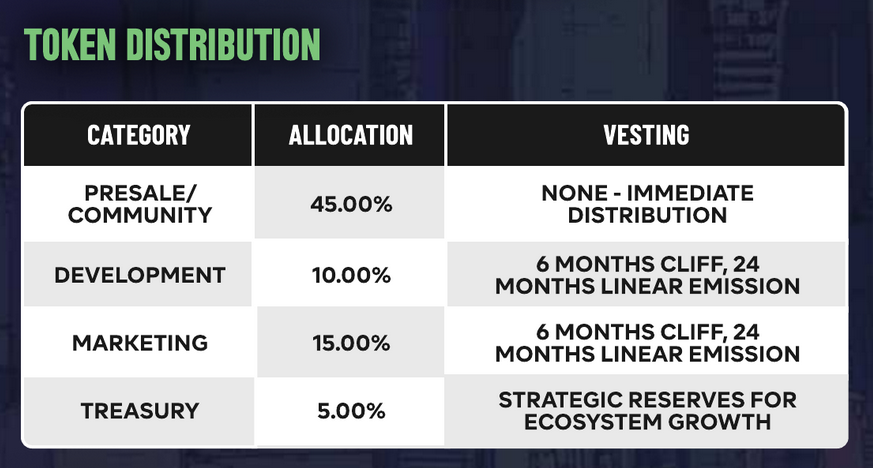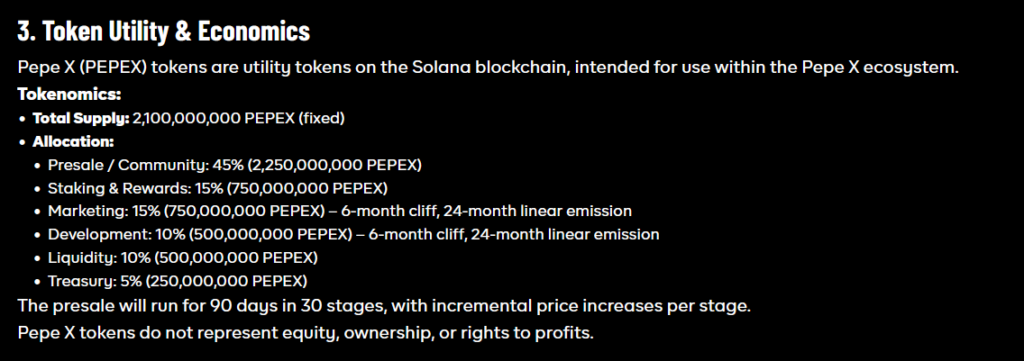Wrapped in Akira metaphors, meme rebellion, and marketing buzzwords, PepeX bills itself as the “world’s first AI-powered tokenization launchpad.” But behind the stylized whitepaper and rebellious branding is a project riddled with contradictions, broken tokenomics, and red flags that are hard to ignore.
Table of Contents
Tokenomics That Don’t Add Up – Literally
The PepeX whitepaper proudly claims 45% of tokens go to the presale, with other slices to development, marketing, and community – but the total only adds up to 75%, leaving 25% of the supply completely unaccounted for:

It gets worse in the Terms & Conditions, which present a completely different set of tokenomics. This time it does add up to 100%, but the numbers break down completely. The document claims a total supply of 2.1 billion PEPEX, yet allocates 2.25 billion tokens to the presale alone:

PEP-20: A Standard That Doesn’t Exist
In the privacy policy, PepeX mention the “PEP-20 token standard”. This standard doesn’t exist.
It appears to be taken from another still-running presale project: Bitcoin Pepe, which uses the same terminology. In fact, a side-by-side comparison of both projects’ legal documents shows extensive copy-paste similarities.
The most likely explanation is that the PepeX team copied Bitcoin Pepe’s legal documents and forgot to remove or replace references to PEP-20.
We have our reservations for the Bitcoin Pepe presale as well, which we described in our index.
$500 Launch Fee Is Absurd
The PepeX whitepaper spends a lot of time explaining how its launchpad will revolutionize memecoin creation – describing anti-sniping features, better liquidity models, and AI-powered marketing tools. But then, buried in the FAQ:

That instantly kills the whole value proposition. Compare that to pump.fun, the very platform PepeX is supposedly overthrowing – which charges just a few dollars. No matter how many flashy features PepeX promises, most users will never pay $500 to launch a meme token.
The Features Are Not There
Speaking of those features – there’s no evidence they even exist. There are no testnets, to code repositories, no screenshots, no demos. The audit by SolidProof only reviewed a basic Solana SPL token – not the launchpad and the promised features.
Some might argue that the token is still in its presale stage, and that the launchpad will be developed using the raised funds – but we don’t even know how much funding is needed, especially when the project presents two different, contradictory tokenomics models, and both are mathematically incorrect.
Anonymous Team, Offshore Jurisdiction
There are no names, no LinkedIn profiles, no proof of credentials. The jurisdiction is Saint Vincent and the Grenadines – a classic choice for crypto projects looking to dodge regulation while offering zero investor protection.
The only point in their favor is the KYC process mentioned in the audit, but in our view, that’s not nearly enough. SolidProof claims it will release the team’s data “in case of fraud”, but that doesn’t guarantee accountability. We don’t know how many individuals were verified, what jurisdiction they fall under, or whether the information provided would hold up under legal scrutiny.
Final Verdict
A nonexistent token standard, a $500 fee to launch a token, two sets of tokenomics – and both are wrong. Add to that the usual red flags: no proof of development, no transparency, and an anonymous team. You can draw your own conclusion.
Wondering if a crypto presale is legit or a cleverly marketed scam?
We’ve got you covered. Our new Presale Index lets you look up presales you’re interested in and check for red flags before investing.




